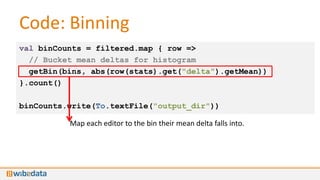Performing Data Science with HBase
- 2. Performing Data Science with HBase Aaron Kimball – CTO Kiyan Ahmadizadeh – MTS
- 3. MapReduce and log files Log files Batch analysis Result data set
- 4. The way we build apps is changing
- 5. HBase plays a big role • High performance random access • Flexible schema & sparse storage • Natural mechanism for time series data … organized by user
- 8. Data science lays the groundwork • Feature selection requires insight • Data lies in HBase, not log files • MapReduce is too cumbersome for exploratory analytics
- 9. Data science lays the groundwork • Feature selection requires insight • Data lies in HBase, not log files • MapReduce is too cumbersome for exploratory analytics • This talk: How do we explore data in HBase?
- 10. Why not Hive? • Need to manually sync column schemas • No complex type support for HBase + Hive – Our use of Avro facilitates complex record types • No support for time series events in columns
- 11. Why not Pig? • Tuples handle sparse data poorly • No support for time series events in columns • UDFs and main pipeline are written in different languages (Java, Pig Latin) – (True of Hive too)
- 12. Our analysis needs • Read from HBase • Express complex concepts • Support deep MapReduce pipelines • Be written in concise code • Be accessible to data scientists more comfortable with R & python than Java
- 13. Our analysis needs • Concise: We use Scala • Powerful: We use Apache Crunch • Interactive: We built a shell wibi>
- 14. WDL: The WibiData Language wibi> 2 + 2 wibi> :tables res0: Int = 4 Table Description ======== =========== page Wiki page info user per-user stats
- 15. Outline • Analyzing Wikipedia • Introducing Scala • An Overview of Crunch • Extending Crunch to HBase + WibiData • Demo!
- 16. Analyzing Wikipedia • All revisions of all English pages • Simulates real system that could be built on top of WibiData • Allows us to practice real analysis at scale
- 17. Per-user information • Rows keyed by Wikipedia user id or IP address • Statistics for several metrics on all edits made by each user
- 18. Introducing • Scala language allows declarative statements • Easier to express transformations over your data in an intuitive way • Integrates with Java and runs on the JVM • Supports interactive evaluation
- 19. Example: Iterating over lists def printChar(ch: Char): Unit = { println(ch) } val lst = List('a', 'b', 'c') lst.foreach(printChar)
- 20. … with an anonymous function val lst = List('a', 'b', 'c') lst.foreach( ch => println(ch) ) • Anonymous function can be specified as argument to foreach() method of a list. • Lists, sets, etc. are immutable by default
- 21. Example: Transforming a list val lst = List(1, 4, 7) val doubled = lst.map(x => x * 2) • map() applies a function to each element, yielding a new list. (doubled is the list [2, 8, 14])
- 22. Example: Filtering • Apply a boolean function to each element of a list, keep the ones that return true: val lst = List(1, 3, 5, 6, 9) val threes = lst.filter(x => x % 3 == 0) // ‘threes’ is the list [3, 6, 9]
- 23. Example: Aggregation val lst = List(1, 2, 12, 5) lst.reduceLeft( (sum, x) => sum + x ) // Evaluates to 20. • reduceLeft() aggregates elements left-to-right, in this case by keeping a running sum.
- 24. Crunch: MapReduce pipelines def runWordCount(input, output) = { val wordCounts = read(From.textFile(input)) .flatMap(line => line.toLowerCase.split("""s+""")) .filter(word => !word.isEmpty()) .count wordCounts.write(To.textFile(output)) }
- 25. PCollections: Crunch data sets • Represent a parallel record-oriented data set • Items in PCollections can be lines of text, tuples, or complex data structures • Crunch functions (like flatMap() and filter()) do work on partitions of PCollections in parallel.
- 26. PCollections… of WibiRows • WibiRow: Represents a row in a Wibi table • Enables access to sparse columns • … as a value: row(someColumn): Value • … As a timeline of values to iterate/aggregate: row.timeline(someColumn): Timeline[Value]
- 28. Demo!
- 29. Demo: Visualizing Distributions • Suppose you have a metric taken on some population of users. • Want to visualize what the distribution of the metric among the population looks like. – Could inform next analysis steps, feature selection for models, etc. • Histograms can give insight on the shape of a distribution. – Choose a set of bins for the metric. – Count the number of population members whose metric falls into each bin.
- 30. Demo: Wikimedia Dataset • We have a user table containing the average delta for all edits made by a user to pages. • Edit Delta: The number of characters added or deleted by an edit to a page. • Want to visualize the distribution of average deltas among users.
- 31. Demo!
- 32. Code: Accessing Data val stats = ColumnFamily[Stats]("edit_metric_stats") val userTable = read( From.wibi(WibiTableAddress.of("user"), stats))
- 33. Code: Accessing Data val stats = ColumnFamily[Stats]("edit_metric_stats") val userTable = read( From.wibi(WibiTableAddress.of("user"), stats)) Will act as a handle for accessing the column family.
- 34. Code: Accessing Data val stats = ColumnFamily[Stats]("edit_metric_stats") val userTable = read( From.wibi(WibiTableAddress.of("user"), stats)) Type annotation tells WDL what kind of data to read out of the family.
- 35. Code: Accessing Data val stats = ColumnFamily[Stats]("edit_metric_stats") val userTable = read( From.wibi(WibiTableAddress.of("user"), stats)) userTable is a PCollection[WibiRow] obtained by reading the column family “edit_metric_stats” from the Wibi table “user.”
- 36. Code: UDFs def getBin(bins: Range, value: Double): Int = { bins.reduceLeft ( (choice, bin) => if (value < bin) choice else bin ) } def inRange(bins: Range, value: Double): Boolean = range.start <= value && value <= range.end
- 37. Code: UDFs def getBin(bins: Range, value: Double): Int = { bins.reduceLeft ( (choice, bin) => if (value < bin) choice else bin ) } def inRange(bins: Range, value: Double): Boolean = range.start <= value && value <= range.end Everyday Scala function declarations!
- 38. Code: Filtering val filtered = userTable.filter { row => // Keep editors who have edit_metric_stats:delta defined !row(stats).isEmpty && row(stats).get.contains("delta") }
- 39. Code: Filtering val filtered = userTable.filter { row => // Keep editors who have edit_metric_stats:delta defined !row(stats).isEmpty && row(stats).get.contains("delta") } Boolean predicate on elements in the PCollection
- 40. Code: Filtering val filtered = userTable.filter { row => // Keep editors who have edit_metric_stats:delta defined !row(stats).isEmpty && row(stats).get.contains("delta") } filtered is a PCollection of rows that have the column edit_metric_stats:delta
- 41. Code: Filtering val filtered = userTable.filter { row => // Keep editors who have edit_metric_stats:delta defined !row(stats).isEmpty && row(stats).get.contains("delta") } Use stats variable we declared earlier to access the column family. val stats = ColumnFamily[Stats]("edit_metric_stats")
- 42. Code: Binning val binCounts = filtered.map { row => // Bucket mean deltas for histogram getBin(bins, abs(row(stats).get("delta").getMean)) }.count() binCounts.write(To.textFile("output_dir"))
- 43. Code: Binning val binCounts = filtered.map { row => // Bucket mean deltas for histogram getBin(bins, abs(row(stats).get("delta").getMean)) }.count() binCounts.write(To.textFile("output_dir")) Map each editor to the bin their mean delta falls into.
- 44. Code: Binning val binCounts = filtered.map { row => // Bucket mean deltas for histogram getBin(bins, abs(row(stats).get("delta").getMean)) }.count() binCounts.write(To.textFile("output_dir")) Count how many times each bin occurs in the resulting collection.
- 45. Code: Binning val binCounts = filtered.map { row => // Bucket mean deltas for histogram getBin(bins, abs(row(stats).get("delta").getMean)) }.count() binCounts.write(To.textFile("output_dir")) binCounts contains the number of editors that fall in each bin.
- 46. Code: Binning val binCounts = filtered.map { row => // Bucket mean deltas for histogram getBin(bins, abs(row(stats).get("delta").getMean)) }.count() binCounts.write(To.textFile("output_dir")) Writes the result to HDFS.
- 47. Code: Visualization Histogram.plot(binCounts, bins, "Histogram of Editors by Mean Delta", "Mean Delta", "Number of Editors", "delta_mean_hist.html")
- 48. Analysis Results: 1% of Data
- 49. Analysis Results: Full Data Set
- 50. Conclusions + + = Scalable analysis of sparse data
- 51. Aaron Kimball – [email protected] Kiyan Ahmadizadeh – [email protected]


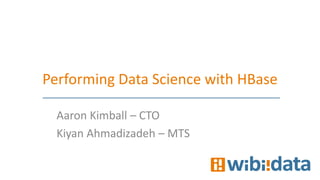








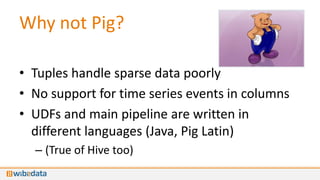







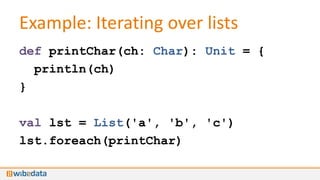

![Example: Transforming a list
val lst = List(1, 4, 7)
val doubled = lst.map(x => x * 2)
• map() applies a function to each element,
yielding a new list. (doubled is the list [2,
8, 14])](https://image.slidesharecdn.com/hadoop-world-2012-web-121029204205-phpapp02/85/Performing-Data-Science-with-HBase-21-320.jpg)
![Example: Filtering
• Apply a boolean function to each element of a
list, keep the ones that return true:
val lst = List(1, 3, 5, 6, 9)
val threes =
lst.filter(x => x % 3 == 0)
// ‘threes’ is the list [3, 6, 9]](https://image.slidesharecdn.com/hadoop-world-2012-web-121029204205-phpapp02/85/Performing-Data-Science-with-HBase-22-320.jpg)



![PCollections… of WibiRows
• WibiRow: Represents a row in a Wibi table
• Enables access to sparse columns
• … as a value: row(someColumn): Value
• … As a timeline of values to iterate/aggregate:
row.timeline(someColumn): Timeline[Value]](https://image.slidesharecdn.com/hadoop-world-2012-web-121029204205-phpapp02/85/Performing-Data-Science-with-HBase-26-320.jpg)

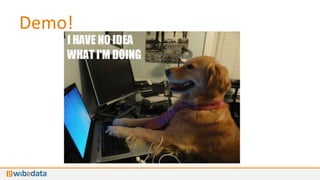




val userTable = read(
From.wibi(WibiTableAddress.of("user"), stats))](https://image.slidesharecdn.com/hadoop-world-2012-web-121029204205-phpapp02/85/Performing-Data-Science-with-HBase-32-320.jpg)

val userTable = read(
From.wibi(WibiTableAddress.of("user"), stats))
Will act as a handle
for accessing the
column family.](https://image.slidesharecdn.com/hadoop-world-2012-web-121029204205-phpapp02/85/Performing-Data-Science-with-HBase-33-320.jpg)

val userTable = read(
From.wibi(WibiTableAddress.of("user"), stats))
Type annotation tells
WDL what kind of
data to read out of
the family.](https://image.slidesharecdn.com/hadoop-world-2012-web-121029204205-phpapp02/85/Performing-Data-Science-with-HBase-34-320.jpg)

val userTable = read(
From.wibi(WibiTableAddress.of("user"), stats))
userTable is a PCollection[WibiRow] obtained by reading the
column family “edit_metric_stats” from the Wibi table
“user.”](https://image.slidesharecdn.com/hadoop-world-2012-web-121029204205-phpapp02/85/Performing-Data-Science-with-HBase-35-320.jpg)



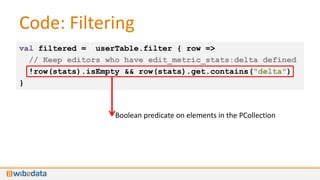

](https://image.slidesharecdn.com/hadoop-world-2012-web-121029204205-phpapp02/85/Performing-Data-Science-with-HBase-41-320.jpg)

